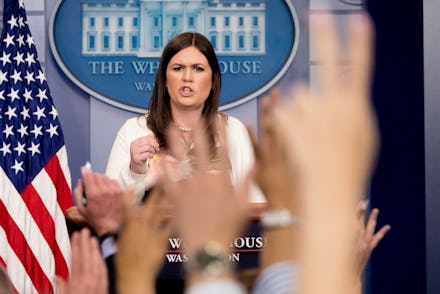Another day, another off-camera White House press briefing

This week, Donald Trump's White House informed reporters of the terms of a press briefing with deputy press secretary Sarah Huckabee Sanders scheduled for the following day: no cameras allowed.
It wasn't the first time the White House's briefing schedule told reporters that broadcast and audio recordings were forbidden at the gaggle, and the move frustrated and concerned members of the press who in recent months have watched the White House move away from the longstanding White House tradition of holding a daily, on-camera and on-the-record press briefing with the press secretary.
On Thursday, reporters were informed that news outlets could use audio of the recording, but could only air the recordings after the press briefing had concluded.
When Sanders stepped up to the podium, the cameras on network news and cable channels cut out.
The move to scale back on-camera press briefings comes amid Trump's increasing unwillingness to interact with the press. The president has in recent months favored Trump-friendly channel Fox News for interviews, and he has not held an official press conference since February.
Thursday's off-camera briefing, of which CNN aired an audio recording after the fact, came amid an attempt to pass a deeply unpopular and extremely secretive health care bill through the legislature — not to mention ongoing questions about the various investigations involving Russian interference in the 2016 election and members of Trump's presidential campaign.
The move also mirrors the short-lived and controversial decision by the White House in March to break from the daily on-camera briefing with an off-camera gaggle, which several major news outlets were not allowed to attend.
The increasing regularity of the White House's scaling back of press access has prompted many reporters to wonder how best to handle the decision, which is being viewed as a move to make the administration less transparent.
After the White House said that a briefing held on June 19 was "not for broadcast or audio," CNN's Jim Acosta slammed the decision.
"It feels like we're slowly but surely being dragged into what is a new normal in this country, where the president of the United States is allowed to insulate himself from answering hard questions," Acosta said Monday, while speaking with CNN's Brooke Baldwin. "I don't know why we covered that gaggle today, quite honestly … If they can't give us the answers to the questions on camera or where we can record the audio, they're basically pointless at this point."
On Thursday, Acosta spoke out again.
The White House has defended its decision to scale back its on-camera press briefings. Spicer, on Monday, said that on-camera briefings were just a part of a larger media strategy, and he told right-wing radio host Laura Ingraham (whose name has been floated as a candidate to replace Spicer) that the decision prevented attention-seeking reporters from trying "to become YouTube stars."
The White House's daily guidance has also begun instructing reporters not to report on the part of the guidance telling them that the press briefings are not to be broadcast or recorded.